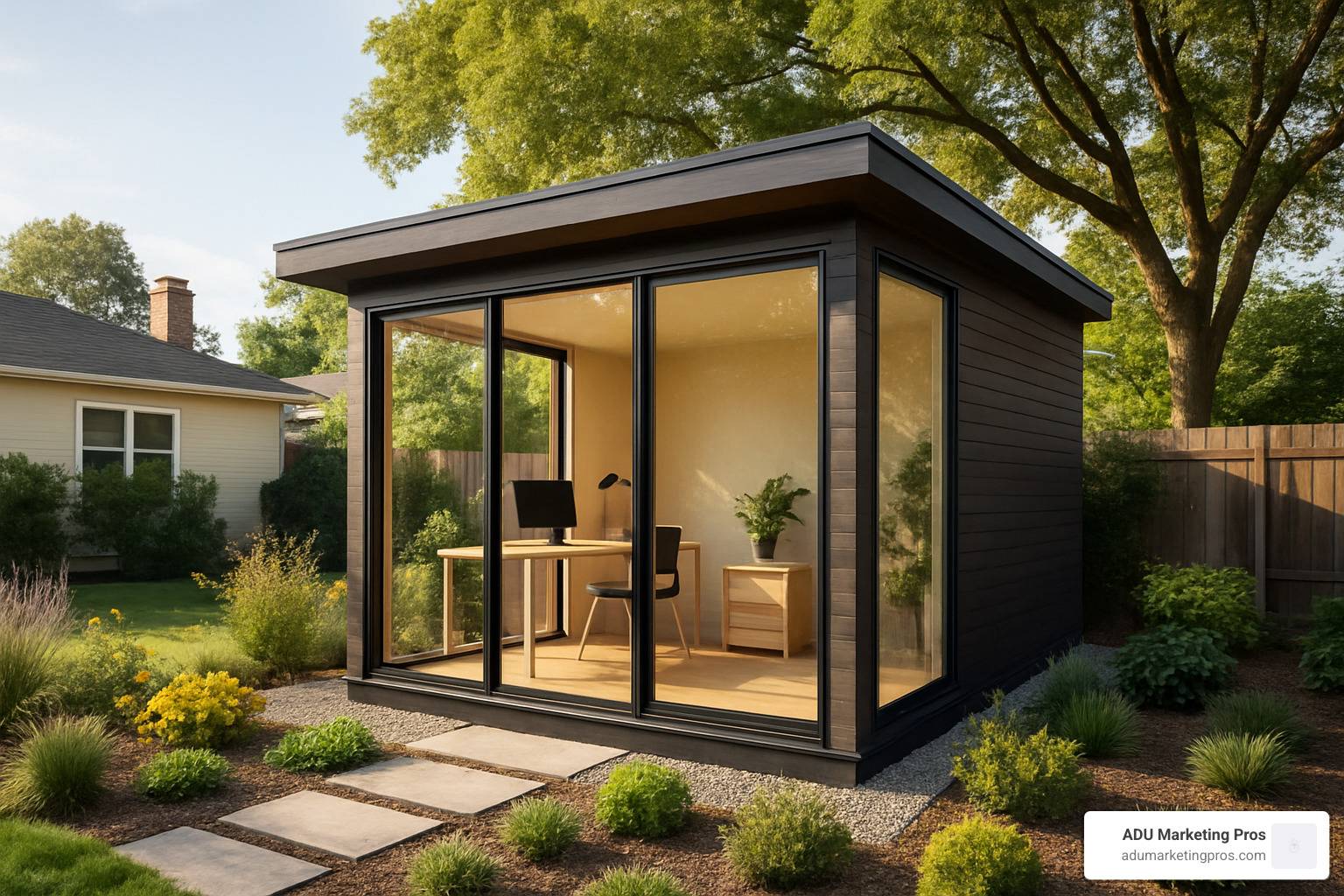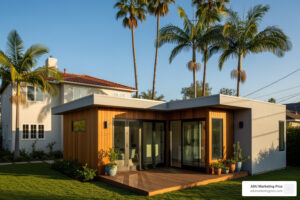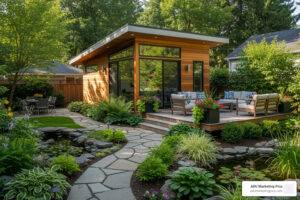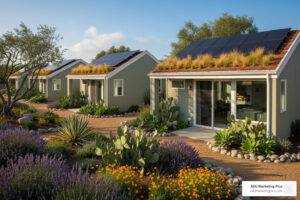Why ADU Home Offices Are Changing Remote Work
An ADU home office is a separate accessory dwelling unit designed specifically for work, offering dedicated workspace without leaving your property. These backyard offices range from 60-square-foot pods to 500+ square foot custom buildings with full amenities.
Quick ADU Home Office Guide:
- Prefab Pods (60-120 sq ft): $10,900-$32,000, no permits needed, 2-hour to 1-week install
- Panelized Sheds (120-250 sq ft): $27,000-$96,000, moderate permitting, 1-2 week assembly
- Custom ADUs (250+ sq ft): $80,000-$300,000, full permits required, 6-9 month timeline
- Garage Conversions: $41,500+ typical cost, existing structure advantage
The remote work boom has created massive demand for dedicated home offices. Nearly 30% of Americans were self-employed as of 2019, and that number jumped during the pandemic. Traditional home offices inside the main house create constant distractions – kids running around, household noise, and blurred work-life boundaries.
ADU home offices solve these problems completely.
A Los Angeles psychologist saved $2,700 per month by building a stand-alone ADU office instead of renting commercial space. His monthly cost dropped from $3,200 in office rent to just $500 added to his mortgage payment. Meanwhile, his home’s value increased by more than the ADU’s construction cost.
The separation is key. As one Austin homeowner put it after building a 200-square-foot ADU office for $41,500: “Building the ADU was the best decision for our property. It’s allowed us to keep living comfortably in a smaller home.”
Studio Shed reports that many customers find their ADU adds more to their home’s appraised value than the unit cost. Installation of popular sizes takes less than a week, including interior finishes and electrical connections.

ADU home office definitions:
Why an ADU Home Office Beats Traditional Workspaces
Working from home sounds perfect until you’re trying to take a client call while your neighbor’s dog barks and your kids argue over the TV remote. That’s where an ADU home office changes everything.
Picture this: You step out your back door, walk thirty seconds across your yard, and enter your own private workspace. No household chaos, no distractions, no fighting for the kitchen table. Just you, your work, and complete privacy.
This separation isn’t just nice to have – it’s transformative. You can host video conferences without worrying about what’s happening behind you. Take confidential calls without whispering. Work late without disturbing anyone’s sleep. Your ADU home office becomes your professional sanctuary.
The tax advantages make the financial case even stronger. When you’re self-employed, you can deduct business expenses for your ADU office – utilities, maintenance, insurance, even depreciation. Compare that to a traditional home office where you’re limited to deducting only the percentage of your home used for business.
Here’s something that might surprise you: the average American wastes 54 minutes daily just getting to and from work. With an ADU office, your commute becomes a pleasant thirty-second stroll. That’s 234 hours back in your life every year – nearly six full work weeks.
Your property value gets a serious boost too. ADUs in California regularly add 25-35% to a home’s value. One Austin homeowner watched their property jump from $450,000 to $750,000 after adding a 200-square-foot ADU office. The math is simple: spend $100,000, add $150,000 in value.
The flexible use factor multiplies your investment. Your office transforms into a guest suite for visiting relatives, a yoga studio for evening workouts, or even a rental unit generating $1,500-$3,000 monthly income. Scientific research on work-life balance confirms that dedicated workspaces contribute significantly to better mental health and job satisfaction.
Financial Upside of an ADU Home Office
Let’s talk real numbers. The rent savings alone make an ADU home office financially smart. That Los Angeles psychologist we mentioned earlier? He was paying $3,200 monthly for office rent. His ADU mortgage payment increase? Just $500. That’s $2,700 monthly savings – money that now builds equity instead of disappearing to a landlord.
The ROI calculations get even better over time. A $100,000 ADU that adds $150,000 to your property value creates immediate positive equity. Factor in tax deductions, eliminated commute costs, and potential rental income, and you’re looking at a financial home run.
Financing options make ADUs accessible. HELOCs let you tap existing home equity. Cash-out refinancing can fund your ADU while taking advantage of low interest rates. California’s CalHFA program offers $40,000 grants for ADU construction, significantly reducing upfront costs.
The rental income potential adds another revenue stream. When you’re not using your ADU office, it can generate substantial monthly rent. In California markets, well-designed ADU offices rent for $1,500-$3,000 monthly. This income can cover your entire mortgage payment increase, making the ADU essentially pay for itself.
ADU Home Office Options: Product Roundup

Shopping for an ADU home office can feel overwhelming with so many options available. The good news? There’s truly something for every budget, timeline, and workspace need. Let’s walk through the main categories to help you find your perfect match.
Prefab Pods Under 120 sq ft
These little powerhouses pack a surprising amount of functionality into a compact footprint. The biggest advantage? Most areas don’t require permits for structures under 120 square feet, which means you can skip the red tape and get working faster.
Drop Structures offers their Micro model starting at just $10,900 for 60 square feet. Don’t let the size fool you – this tiny office includes proper insulation, electrical connections, and can be delivered and set up in just two hours. Over 350 of these pods have been installed nationwide.
If you need a bit more room to stretch, the POD 1 liv simply pod gives you 106 square feet starting at $32,000. The higher price reflects premium finishes and completely turnkey installation. You literally walk into a finished office with flooring, lighting, and climate control ready to go.
The beauty of these mini offices lies in their simplicity. Most arrive on a trailer and can be crane-lifted into position or assembled on-site in less than a week. The flat-pack design means they can reach spots where traditional construction equipment can’t go.
Panelized Sheds (120–250 sq ft)
This sweet spot category offers more breathing room while still maintaining relatively quick installation. Panelized construction uses pre-built wall sections that get assembled on your property – think of it as sophisticated adult Lego blocks.
Studio Shed’s Signature Series ranges from a cozy 8’x8′ up to a spacious 12’x20′, with prices starting at $10,500. Their panelized system is designed for installation without cranes or heavy machinery, making it perfect for DIY enthusiasts.
kitHAUS brings their k3 series spanning 81-491 square feet, starting at $27,000. These units put a premium on sustainable materials and energy efficiency – great if you’re environmentally conscious.
For something with Scandinavian flair, Plús Hús offers 320 square feet starting at $47,000. The Icelandic-inspired design includes high-performance insulation and low-E glazing to keep you comfortable year-round.
Assembly typically takes 5-9 days and includes electrical rough-in. The panelized approach reduces construction waste by 85% compared to traditional building methods. More info about ADU Construction Leads shows growing demand for these mid-size units.
Custom ADU Home Offices 250 sq ft+
When you want maximum functionality and the highest property value boost, custom ADUs offer unlimited possibilities. Yes, they require full permitting and take longer to complete, but the results speak for themselves.
Full ADU requirements include a bathroom, kitchen facilities, and bedroom-capable space. Even if you’re primarily using it as an office, these features mean you can host overnight guests or generate rental income when needed.
Design flexibility becomes your superpower with custom builds. You can optimize every square foot exactly how you want it. Need a conference room for client meetings? Done. Want a separate entrance for professional visits? No problem.
Timeline considerations typically run 6-9 months including permits and construction. While that’s longer than prefab options, you’re getting a permanent structure that integrates seamlessly with your home’s architectural style.
Cost ranges usually span $80,000-$300,000 depending on size, finishes, and site conditions. The higher investment reflects permanent construction, full utilities, and professional architectural design.
Garage-to-ADU Conversions
Converting existing garage space offers unique advantages for ADU home office projects. You’re working with an existing structure, foundation, and often electrical service – it’s like getting a head start on construction.
Cost advantages can be significant when you’re not starting from zero. That Austin homeowner we mentioned earlier spent just $41,500 total for a 200-square-foot conversion, including $32,542 for the prefab kit, $1,500 for site prep, and $1,100 for HVAC.
Timeline benefits make conversions attractive for people who need their office space quickly. The prefab approach allows completion in 2-4 weeks from delivery to occupancy. Traditional garage conversions take 2-3 months but offer more customization options.
Designing a High-Performance ADU Home Office

The difference between a good ADU home office and a great one comes down to thoughtful design. You’re working with limited square footage, so every decision matters. The most successful ADU offices feel spacious, comfortable, and inspiring – not cramped or makeshift.
Natural light transforms any workspace. Position your desk near a north-facing window for consistent, glare-free illumination throughout the day. Skylights work beautifully in ADUs, flooding the space with daylight while keeping your work private from neighbors.
Soundproofing might seem like overkill, but it’s essential for professional calls and deep focus. Acoustic insulation in walls and ceilings makes a dramatic difference. Double-pane windows and solid-core doors further reduce noise transmission.
Climate control keeps you productive year-round. Mini-split HVAC systems work perfectly for ADU offices, providing both heating and cooling with individual temperature control. Proper insulation (R-21 or higher) reduces energy costs and eliminates hot or cold spots.
The ergonomic layout prevents fatigue during long work sessions. Plan your desk height, monitor placement, and seating to support good posture. Include a standing desk option if possible – your back will thank you.
Don’t underestimate your technology infrastructure. Run ethernet cables during construction for the most reliable internet connection. Plan adequate electrical outlets and USB charging stations throughout the space.
7 Must-Have Features for Every ADU Home Office
Creating the perfect ADU home office means incorporating features that maximize both functionality and comfort. These seven elements consistently appear in the most successful ADU offices we’ve seen.
Floor-to-ceiling storage makes every square foot count. Built-in shelving, cabinets, and filing systems keep supplies organized without consuming precious floor area. Custom millwork can hide storage behind panels, maintaining clean lines while providing ample space.
A Murphy bed transforms your office into a guest room instantly. Modern Murphy beds fold seamlessly into custom cabinetry, maintaining the professional appearance during work hours. This dual functionality maximizes your ADU investment.
Acoustic walls ensure privacy and focus during important calls. Sound-proof construction becomes essential when you’re handling confidential client conversations or need deep concentration.
Privacy screens create separation from neighbors and the main house without blocking natural light. Living walls, decorative fencing, or strategic landscaping improve the sense of a separate workspace.
A professional backdrop optimizes your video call appearance. Plan a clean wall behind your desk with good lighting and minimal distractions. Built-in bookcases or carefully chosen artwork create an appealing background for virtual meetings.
Include a relaxation nook to support work-life balance within your ADU. A comfortable chair or small meditation space helps you decompress during breaks without returning to the main house.
Smart lighting adapts to different tasks and times of day. Combine overhead lighting, task lighting, and ambient lighting with dimmer controls. Natural light sensors can automatically adjust artificial lighting levels.
More info about ADU Interior Design Ideas provides additional inspiration for maximizing small spaces effectively.
Sustainability & Energy Efficiency
Building a sustainable ADU home office makes financial sense while reducing your environmental impact. Modern construction techniques and materials create more comfortable spaces that cost less to operate.
SIP (Structural Insulated Panel) construction provides superior insulation and air sealing compared to traditional framing. These panels create a tight building envelope that dramatically reduces heating and cooling costs.
Low-E windows minimize heat transfer while maximizing natural light. Double or triple-pane glazing with low-emissivity coatings keeps interiors comfortable year-round. Proper window placement can eliminate the need for artificial lighting during daylight hours.
Solar-ready design prepares your ADU for renewable energy without requiring immediate investment. Pre-wire for solar panels and battery storage systems during construction. Some ADU offices can achieve net-zero energy consumption, essentially eliminating utility costs.
Prefab construction reduces waste by 85% compared to traditional building methods. Factory production allows precise material ordering and recycling of scraps. Scientific research on natural light and mental health confirms that well-designed workspaces improve both productivity and wellbeing.
Planning, Permitting & Build Timeline for Your ADU Home Office

Successfully building an ADU home office requires careful planning and understanding of local regulations. The permitting process varies significantly by location, but following a systematic approach ensures smooth project completion.
Site review is the critical first step. Evaluate setback requirements, utility access, and soil conditions. Most jurisdictions require ADUs to be at least 4 feet from property lines, though some allow zero setbacks.
Setback requirements determine ADU placement on your lot. Front setbacks typically match the main house, while side and rear setbacks may be reduced for ADUs. Some areas allow ADUs within the existing building envelope, making garage conversions particularly attractive.
Utility connections add complexity and cost. New electrical service, water, and sewer connections require permits and professional installation. Some prefab ADUs can connect to existing house utilities, reducing installation costs.
Financing options include construction loans, HELOCs, and cash-out refinancing. California’s CalHFA program offers $40,000 grants for ADU construction, reopening December 11, 2023.
ADU Home Office Permitting 101
Understanding permitting requirements prevents costly delays and ensures code compliance. California’s SB 35 law has streamlined ADU approval processes, but local variations still exist.
Zoning Compliance is the foundation of ADU permitting. Most single-family residential zones allow ADUs, but check for specific restrictions. Some areas limit ADU size, height, or require owner occupancy.
Square Footage Caps vary by jurisdiction. Many areas allow ADUs up to 1,200 square feet or 50% of the main house size, whichever is smaller. Smaller ADUs (under 500 square feet) often have simplified approval processes.
SB 35 Benefits include streamlined approvals and reduced fees. California law requires ministerial approval for compliant ADU applications, eliminating discretionary review. This process typically takes 60 days or less.
HOA Rules may impose additional restrictions beyond city requirements. Review your CC&Rs carefully and consider seeking HOA approval before submitting city permits.
Cost Breakdown & Financing Paths
ADU home office costs vary dramatically based on size, features, and construction method. Understanding the full cost picture helps you budget effectively and choose appropriate financing.
Budget Tiers break down as follows:
- Economy ($15,000-$50,000): Prefab pods, basic finishes, minimal permits
- Mid-Range ($50,000-$150,000): Panelized sheds, garage conversions, standard finishes
- Premium ($150,000-$300,000): Custom ADUs, high-end finishes, full amenities
HELOC Financing offers flexible access to home equity. Interest rates are typically lower than personal loans, and interest may be tax-deductible. Draw funds as needed during construction to minimize interest costs.
Cash-Out Refinancing allows you to access equity while potentially reducing your mortgage rate. This option works best when current rates are favorable and you have substantial equity.
CalHFA Grant Program provides $40,000 toward ADU construction costs. The program targets moderate-income homeowners and requires owner occupancy. Applications are processed on a first-come, first-served basis.
More info about Custom ADU Blueprints can help you understand design and permitting requirements for your specific project.
Frequently Asked Questions about ADU Home Offices
What size ADU home office can I build without a permit?
Here’s the good news: most California jurisdictions let you build structures under 120 square feet without jumping through the full permitting process. This makes getting your ADU home office up and running much faster and simpler.
However, “no permit” doesn’t mean “no rules.” You still need to respect property line setbacks, height restrictions, and electrical codes. Think of it as building within the existing framework rather than creating something entirely new.
Prefab office pods like the Drop Structures Micro at 60 square feet or Mini Office pods under 120 square feet typically qualify for this streamlined approach. These units can literally be delivered and installed in hours instead of months.
The catch? Some areas have recently reduced this threshold to 100 square feet, so always check with your local building department first. And if you’re in an HOA, their rules might be stricter than city requirements regardless of permit needs.
How long does it take to design and install an ADU home office?
The timeline for your ADU home office depends entirely on which path you choose – and the differences are dramatic.
Prefab pods are the speed champions here. The Mini Office pod can be delivered and installed in as little as 2 hours. Even larger pods requiring foundation work rarely take more than a week from delivery to move-in ready.
Panelized sheds fall into the middle ground at 1-3 months total. You’ll spend 2-4 weeks on design and ordering, wait 3-6 weeks for manufacturing, then watch your new office go up in just 5-9 days of actual installation.
Custom ADUs require the most patience at 6-9 months total. Design and permitting alone consume 2-4 months, followed by 3-5 months of construction. The payoff? You get exactly what you want with maximum property value boost.
Garage conversions offer a sweet spot at 1-4 months total. Prefab conversion kits can transform your garage in 2-4 weeks, while custom conversions take 2-3 months for completion.
Pro tip: Always add a 2-3 month buffer for potential delays, especially during permit review and inspection phases. Mother Nature and municipal bureaucracy don’t always cooperate with our timelines.
Can my ADU home office double as a rental or guest suite later?
Absolutely! This flexibility is one of the biggest advantages of building an ADU home office instead of just converting a spare bedroom. Smart planning during construction opens up multiple revenue streams down the road.
The key is including the right features from the start. A full bathroom with shower (not just a powder room) is essential for both ADU classification and guest comfort. Even a small kitchenette with sink, refrigerator, and microwave transforms the space into a complete living unit.
Separate entrance access increases rental appeal dramatically while maintaining your family’s privacy. Nobody wants strangers walking through their house to reach a rental unit.
Murphy beds or convertible furniture let the space function as both office and bedroom without major renovations. During the day, it’s your professional workspace. At night or on weekends, it becomes a comfortable guest suite.
Many homeowners get creative with scheduling. They use their ADU office during the week and rent it on weekends through Airbnb. Others transition to full-time rental when they retire or change jobs. The rental income can offset construction costs and provide ongoing passive income.
One client told us their ADU office pays for itself twice – once through tax deductions while they use it for work, and again through rental income when they don’t need it. That’s the kind of smart investment that makes financial sense for years to come.
Conclusion

Building an ADU home office isn’t just about creating a workspace – it’s about investing in your future. The numbers speak for themselves: save thousands monthly on rent, build equity instead of paying landlords, and watch your property value soar beyond the construction cost.
The real-world success stories we’ve shared paint a clear picture. That Los Angeles psychologist who saved $2,700 every month by ditching expensive office rent. The Austin homeowner whose property value jumped from $450,000 to $750,000 after adding a simple 200-square-foot ADU. These aren’t outliers – they’re examples of what happens when you make smart property investments.
But the benefits go deeper than dollars and cents. Think about those 54 minutes you spend commuting daily. That’s 234 hours annually – nearly six weeks of your life sitting in traffic. With an ADU home office, your “commute” becomes a peaceful 30-second walk across your backyard.
The mental health improvements are equally valuable. Having a dedicated workspace that you can physically leave behind at the end of the day creates healthy boundaries that working from your kitchen table simply can’t provide.
Your path forward depends on your specific needs and timeline. Quick solutions like prefab pods under 120 square feet can be installed in hours and cost under $15,000. Balanced approaches using panelized sheds offer more space and features while keeping timelines reasonable. Maximum investment custom ADUs provide the highest property value returns and ultimate flexibility.
The remote work revolution isn’t slowing down – it’s accelerating. More professionals are demanding dedicated home offices, and ADU home offices represent the perfect solution. They offer the separation and professionalism of traditional office space with the convenience and cost savings of working from home.
At ADU Marketing Pros, we see this demand as we help construction and architecture firms connect with homeowners ready to build their dream workspaces. The inquiries keep coming, and the projects keep getting more creative and ambitious.
Your future self will thank you for making this investment. Whether you’re building for productivity, property value, or both, an ADU home office delivers returns that compound over time. Start planning today – your perfect workspace is waiting in your backyard.




